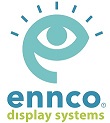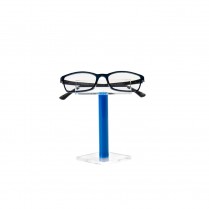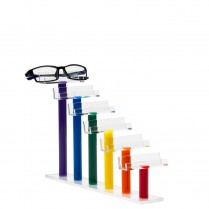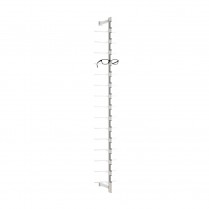The Psychology of Selling and Security!
"We proved the value of our locking display by exhibiting sales of 8 to 1 over the product behind glass"
Long before we had the theft issues of today, merchandisers still felt the need to secure high-end product to make it appear “more appealing”. Of course, there were also some security concerns, but nothing like we read about today with theft in retail optical establishments.
(product featured in image: Sentry Locking Peg)
In the mid 80’s Ennco was approached to solve a cost concern of one of our international customers. They found the cost of putting eyewear behind glass showcases was becoming far too expensive. It was not just the cost of the showcases, but also the cost of constant cleaning and cost of shipping to new stores. They also found that they were not selling as many higher end items as they desired.
Ennco's owner, Jan Ennis, saw an opportunity to expand our product line and test a theory he had as a professional salesperson. The idea was to create an eyewear display that was secure but did not have to be behind glass. He believed that having merchandise behind glass created a psychological barrier to the sale. Sales can happen for a variety of reasons, but the highest level of sales is consultative or problem-solving sales. That does not happen with a barrier between the client, salesperson, and the product.
Ennco spent the better part of a year developing the idea, tooling, and producing the first “single point” locking frame display, which we named “The Foiler”. The concept was simple. We used a hinged polycarbonate bar that would “snap” uniquely into the center of our frame support. The sales staff could then use a simple bifurcated key to unlock the bar making it difficult for thieves to understand how the mechanism worked. To our knowledge, this was the very first single frame locking device produced and patented. The locking concept and mechanism was followed shortly after by a worldwide watch maker and other optical display producers.
Once the product was produced, the theory about the psychological advantage of displays “not behind glass” had to be proven. We were fortunate to have several large retail clients that wanted to test our theory once the product was ready. Sunglasses were used for the test since that opened it up to more than just ophthalmic sales. Several large retailers used “branded locked sunglass cases” in conjunction with a simple stand using our “locking rods that were exposed and not behind glass”. In both cases, we used the EXACT SAME FRAMES. However, to give a perceived advantage to the glass showcase, we did not brand our display. Both displays were placed within several feet of each other.
What happened next is exactly what we expected. Shoppers would walk up to the branded display and stare into it at the sunglasses. The salesperson would walk over and say (quite expectedly), “May I help you?” The typical response was, “No thank you, I’m just looking!” The result of this type sales interaction is just the same as a salesperson handing out pamphlets with no concern for the sale.
The reaction above is purely based on human nature and would not be expected by those that have not spent years in interpersonal sales situations. The opposite is what we were looking for and received! Shoppers would then walk over to our display and peruse the sunglasses. They would reach for the one that they were interested in but could not take off the display due to the security bar. The reaction of the salesperson was then, “Here, let me help you with that!”. As you might expect in this type of “problem solving” sales situation, the client then typically responded, “Thank you!”. The result of this type of interaction is a very positive and helpful experience that tends to lead to a sale.
In these side by side physical and psychological sales tests we proved the value of our locking display by exhibiting sales of 8 to 1 over the product behind glass. Since our introduction of the first “hands on security” for eyewear, display makers around the globe have produced numerous security options for walls, cabinets, and shelving. No matter which way you go, helpful interaction between salespersons and clients/patients will yield far better results than simple browsing.
In the years that have passed since the introduction of locking eyewear displays, we have heard numerous times, “We don’t have enough staff to assist clients to view specific frames”. We might leave you with the thought that if your staff is not able or willing to interact in this highly personal and “high touch” problem solving sales presentation, you are looking at the “1” sale vs. the “8” sales.
If you are looking to secure your frames using "hands on" security check out the many locking display options that we offer!
Mino Rod
Alumina Rod
Sentry (wall or countertop) Locking Peg
Foiler Rod





















